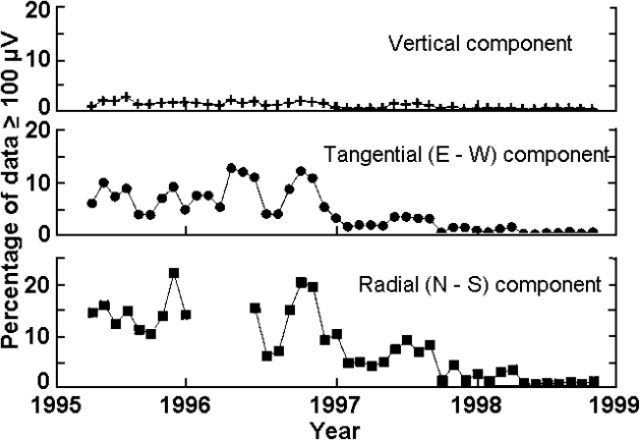Report on Arenal (Costa Rica) — December 1998
Bulletin of the Global Volcanism Network, vol. 23, no. 12 (December 1998)
Managing Editor: Richard Wunderman.
Arenal (Costa Rica) Declining seismic amplitudes since late 1996
Please cite this report as:
Global Volcanism Program, 1998. Report on Arenal (Costa Rica) (Wunderman, R., ed.). Bulletin of the Global Volcanism Network, 23:12. Smithsonian Institution. https://doi.org/10.5479/si.GVP.BGVN199812-345033
Arenal
Costa Rica
10.463°N, 84.703°W; summit elev. 1670 m
All times are local (unless otherwise noted)
A seismic instrument at Arenal has registered declining seismicity since late 1996 (figure 87). The instrument resides at Arenal Observatory Lodge, 2.8 km S of the summit. This three-component instrument (a Marks Products L-4-3D seismometer) interfaced to an automatic data acquisition system has been in nearly continuous operation for several years. The automated system looked at the output during 19-second-long intervals. The plots show seismicity in terms of the monthly percentage of these intervals with maximum amplitudes over 0.1 mV. Each plot corresponds to one of the instrument's three orthogonal components. The vertical component had the lowest amplitudes with only a few percent of the intervals over the threshold, and those occurred mainly in 1995-96. The horizontal components behaved with broad-scale similarity; but the N-S component had more vigorous response, in late 1996 and 1997 over 20% of the intervals extended over the stated threshold.
At Arenal, seismic levels have typically correlated positively with the intensity of pyroclastic outbursts. Decreased seismic intensity has often correlated with the escape of lava flows without pyroclastic outbursts. In harmony with the seismic data, observers noted both escaping lavas and fewer pyroclastic outbursts during much of 1998.
Geological Summary. Conical Volcán Arenal is the youngest stratovolcano in Costa Rica and one of its most active. The 1670-m-high andesitic volcano towers above the eastern shores of Lake Arenal, which has been enlarged by a hydroelectric project. Arenal lies along a volcanic chain that has migrated to the NW from the late-Pleistocene Los Perdidos lava domes through the Pleistocene-to-Holocene Chato volcano, which contains a 500-m-wide, lake-filled summit crater. The earliest known eruptions of Arenal took place about 7000 years ago, and it was active concurrently with Cerro Chato until the activity of Chato ended about 3500 years ago. Growth of Arenal has been characterized by periodic major explosive eruptions at several-hundred-year intervals and periods of lava effusion that armor the cone. An eruptive period that began with a major explosive eruption in 1968 ended in December 2010; continuous explosive activity accompanied by slow lava effusion and the occasional emission of pyroclastic flows characterized the eruption from vents at the summit and on the upper western flank.
Information Contacts: Jorge Barquero, Observatorio Vulcanológico y Sismológico de Costa Rica, Universidad Nacional (OVSICORI-UNA), Apartado 86-3000, Heredia, Costa Rica; William Melson and Sara James, Department of Mineral Sciences, Smithsonian Institution, Washington, DC 20560-0119 USA.


